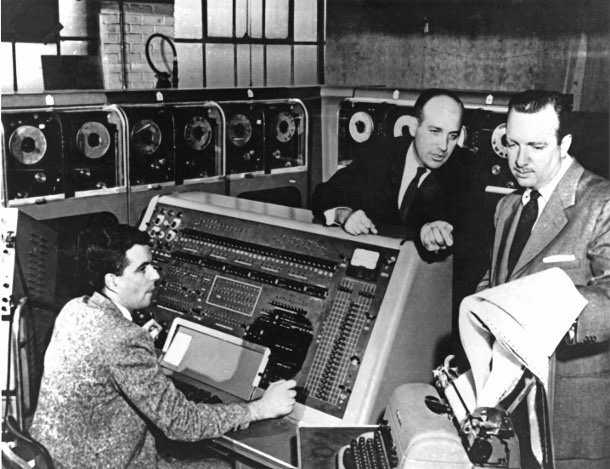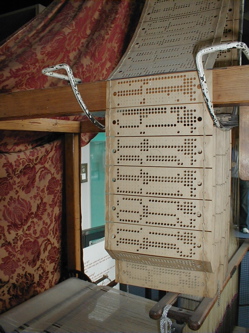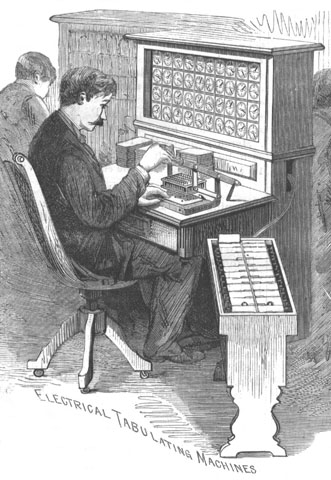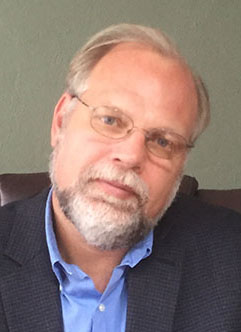|
|
|
|
DAVID HALSTED
In
Search of the
Internet:
The Early
History of
Punched-card
Technology
from the
Jacquard loom
to IBM
The
Lounge at Iwan
Ries
Tuesday, February 2,
2016
5:30-8:30pm
Reservations
are required.
Where
did the internet
come from? One
story goes this
way:
In
the beginning,
electronic computers
were thought of as
giant calculators,
created in Cold War labs to help guide
artillery shells,
build bombs, and
detect incoming
bombers. The
Pentagon linked
descendants of these
machines into the
ARPANET, the network
that would become
the internet. By the
late 1980s the stage
was set for Tim
Berners-Lee’s
invention of the
World Wide Web, but
it was really with
the opening of the
Internet to
commercial traffic,
the appearance of
the Mosaic browser
in 1994, and the
Netscape IPO in 1995
that networked
computing exploded
into the culture as
a whole, setting the
stage for our own
world of ubiquitous
internet access and
algorithms, for
tablets, smart
phones, wearables,
and the Internet of
Things. In a
nutshell, that is
the story of
computing and the
internet as it is
often told.
labs to help guide
artillery shells,
build bombs, and
detect incoming
bombers. The
Pentagon linked
descendants of these
machines into the
ARPANET, the network
that would become
the internet. By the
late 1980s the stage
was set for Tim
Berners-Lee’s
invention of the
World Wide Web, but
it was really with
the opening of the
Internet to
commercial traffic,
the appearance of
the Mosaic browser
in 1994, and the
Netscape IPO in 1995
that networked
computing exploded
into the culture as
a whole, setting the
stage for our own
world of ubiquitous
internet access and
algorithms, for
tablets, smart
phones, wearables,
and the Internet of
Things. In a
nutshell, that is
the story of
computing and the
internet as it is
often told.
 But
this version of
the story
makes it hard to
understand how the
giant defense
calculators evolved
into social
machines—into
devices we use to
communicate and
interact. That
part of computing
history makes more
sense when we start
the story a little
earlier. In
the textile mills of
the Industrial
Revolution, Jacquard
looms used loops of
punched cards to
stored complex
patterns for woven
cloth.
Charles Babbage
dreamed of using
similar cards to
program his
never-built
Analytical Engine,
and his intellectual
partner, Ada,
Countess of
Lovelace, the
daughter of Lord
Byron, saw that the
Engine could handle
not just numbers,
but symbols of any
sort. But
this version of
the story
makes it hard to
understand how the
giant defense
calculators evolved
into social
machines—into
devices we use to
communicate and
interact. That
part of computing
history makes more
sense when we start
the story a little
earlier. In
the textile mills of
the Industrial
Revolution, Jacquard
looms used loops of
punched cards to
stored complex
patterns for woven
cloth.
Charles Babbage
dreamed of using
similar cards to
program his
never-built
Analytical Engine,
and his intellectual
partner, Ada,
Countess of
Lovelace, the
daughter of Lord
Byron, saw that the
Engine could handle
not just numbers,
but symbols of any
sort.
At the end of the
19th century the
American-born son of
a German immigrant,
Herman Hollerith,
implemented a system
that used punched
cards to handle
data.
Working in tandem
with John Shaw
Billings, a
physician and
statistician (and
the first director
of the New York
Public Library),
Hollerith’s punched
cards and tabulators
helped process the
1890 US census in
record time. Then he
turned to other
kinds of data, for
railroads, insurance
and the retail
trade. One of
the first
large-scale retail
installations, at
Marshall Field and
Company, was
churning through
10,000 cards a day
by 1907.  The
company Hollerith
founded would become
IBM; punched cards
would become the
mainstay of
information storage
and processing until
the digital
electronic computer
displaced them. The
company Hollerith
founded would become
IBM; punched cards
would become the
mainstay of
information storage
and processing until
the digital
electronic computer
displaced them.
Hollerith’s
expansion into
different markets
was based on the
idea that
information
technology could be
used to represent,
recombine and
manipulate many
kinds of objects in
the
world.
The modern computer
is much more than a
calculator because
it participates in
and helps us build
our culture.
It can do this
because of the
representational
flexibility that
traces back to the
punched card.
When we watch Herman
Hollerith stretch
the limits of the
technology he
invented, we see our
own world in the
making.
In the textile mills
of the Industrial
Revolution, Jacquard
looms used loops of
punched cards to
stored complex
patterns for woven
cloth. By the
end of the 19th
century, punched
card technology was
being used to
process census,
health, and business
data.  The
leading company in
punched card
technology, IBM,
would play a key
role in history of
electronic
computing.
This presentation
describes how the
punched card evolved
and how it
contributed to the
information
revolution as we
know it today. The
leading company in
punched card
technology, IBM,
would play a key
role in history of
electronic
computing.
This presentation
describes how the
punched card evolved
and how it
contributed to the
information
revolution as we
know it today.
 David
Halsted has a
BA (St. John’s,
Annapolis, 1983) and
a PhD in comparative
literature
(University of
Michigan,
1991). David
Halsted has a
BA (St. John’s,
Annapolis, 1983) and
a PhD in comparative
literature
(University of
Michigan,
1991).
Dr.
Halsted writes,
"I
have a
background as
both an academic
and a
technologist.
I’ve taught
college-level
courses in
literature and
history and have
been working on
web
pages and
applications
since the
mid-1990s.
I recently left
the University
of Illinois at
Chicago, where I
was Director of
Online and
Blended Learning
in the College
of Liberal Arts
and Sciences, to
pursue freelance
and start-up
projects."
|
|
About
the
Cigar Society of
Chicago
ONE OF
THE OLDEST AND greatest
traditions of the city
clubs of Chicago is the
discussion of
intellectual, social,
legal, artistic,
historical, scientific,
musical, theatrical, and
philosophical issues in
the company of educated,
bright, and
appropriately
provocative individuals,
all under the beneficent
influence of substantial
amounts of tobacco and
spirits. The
Cigar Society of
Chicago
embraces this tradition
and extends it with its
Informal Smokers,
University Series
lectures, and Cigar
Society Dinners,
in which cigars, and
from time to time pipes
and cigarettes, appear
as an important
component of our version
of the classical
symposium. To be
included in the Cigar
Society's mailing list,
write to the secretary
at
curtis.tuckey@logicophilosophicus.org
|
|
|
|
|